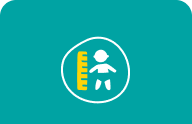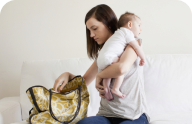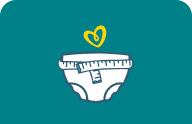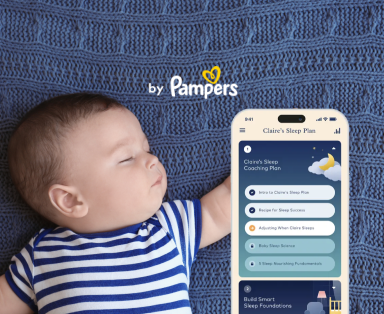Tips for Getting Your Baby to Sleep in a Crib
IN THIS ARTICLE
Sleep plays an essential role in your baby’s happy and healthy development, and experts advise that the safest place for your little one to slumber is a crib. That said, how to get your baby to sleep in a crib is the big question for many parents! You’re not alone if your child resists falling asleep in their crib and possibly prefers the comfort of your cozy arms. Find out how to help your baby associate the crib with sleep, how long you can use a crib for your baby, and what you can do to ensure your little one’s crib is safe for their necessary snoozes.
How to Get Your Baby to Sleep in a Crib
When it comes to getting your baby to sleep in a crib, timing is critical. Experts recommend placing your baby in the crib at the first signs of drowsiness and not waiting until they’ve fallen asleep. This helps your baby learn to associate the crib as the place of sleep. To figure out how to get your baby to sleep in a crib (or to fall asleep in general), consider the following questions and insights:
Is there an obvious reason? Sometimes, your baby won’t sleep in a crib (or anywhere) because they need something. Check whether your little one needs feeding or a diaper change (how often to change a diaper), or whether they may be feeling sick.
Is your baby comfortable? Check that the room temperature (baby sleep temperature) is cool but comfortable for your baby to sleep and that your little one isn’t over- or underdressed. Have you tried soothing sounds? If your baby won’t sleep in their crib, try playing white noise or soothing sounds using a baby sound machine or creating white noise by turning on a fan pointed toward a wall.
Would a night-light help? Every baby is unique, but your baby might prefer having a night-light on as they fall asleep. A night-light can also provide enough illumination for middle-of-the-night feedings and diaper changes, so you avoid disturbing your baby by turning on the bedroom lights.
Does your baby need something to look at? Believe it or not, one of the tricks on how to get your baby to sleep in a crib is to offer some distraction! A mobile above your baby’s crib can give your little one something to look at, which could help settle them down as they get sleepy. Just remember to keep it out of your baby’s reach!
As a parent, you might be wondering how much should a newborn sleep or what to do when your baby is crying. Consult your child’s healthcare provider if you have any concerns but know that all your efforts to get your baby to sleep in their crib are not in vain! They will help your little one catch all the Zs they need.
For help with getting your baby to sleep in their crib as well as expertly curated sleep classes and step-by-step support, download the Smart Sleep Coach app by Pampers. Co-developed by pediatricians and sleep experts, the app can help you get your baby’s sleep back on track. Get started today by taking the FREE sleep assessment.
Creating a Bedtime Routine
In addition to the tips above, getting your baby to sleep in a crib requires another essential tool: a bedtime routine. Setting up and following a consistent bedtime routine can eventually help your baby fall asleep in their crib. Over time, your baby will get used to the winding down period and start to anticipate sleep, which can help to get them to sleep in their crib. A bedtime routine can include anything that's soothing for your baby, such as the following:
A warm bath
A relaxing massage
Singing or reading
Quiet play
Dimming the lights.
An important part of a successful routine is maintaining a consistent bedtime. This will help your baby get into a sleep schedule over time.
Your baby's schedule may be occasionally disrupted if something comes up, like an outing or overnight travel. In these instances, do your best to stay close to your baby’s usual bedtime, and resume the routine as soon as possible.
For more advice on how to manage disrupted routines, watch the video below:
Why Your Baby Might Not Want to Sleep in a Crib
When you put your little one down for a nap or sleep, cries and protests aren’t necessarily communicating that your baby won’t sleep in a crib; rather, they’re a natural response to being away from you. Your baby knows you exist and loves you, so being away from you may lead to some tears and protests. Crying and separation anxiety are natural and normal, and in many cases, babies will cry or fuss for only a few minutes before dropping off to sleep.
Consult your baby's healthcare provider if you have any questions or concerns about your little one’s sleep schedule, and get even more advice by downloading our new parents’ guide!
When to Start Using a Crib
Your baby’s crib is an essential item, but when should they start sleeping in it? Many, if not most, parents start using one right away when they bring their newborn home from the hospital. Other parents prefer to have their baby sleep in a bassinet for a few weeks, as it’s more portable than a crib. (Getting your baby to sleep in a bassinet is similar to getting your little one to sleep in a crib, so you can follow the same advice.) Can newborns sleep in a crib? Absolutely! It's safe and common for newborns to sleep in a crib from day one. Keep in mind that a baby will outgrow a bassinet quickly, often in the first month, so you may prefer to skip this item altogether and have your baby sleep in a crib from the get-go.
When to Stop Using a Crib
Along with asking when to start using a crib, parents also wonder how long babies sleep in cribs. There’s no standard age for outgrowing a crib and switching to a bed, as all children grow at different rates. Consider the following to determine when to stop using a crib for your child:
By the time your child is about three feet tall, they should no longer sleep in a crib, according to experts.
Check the manufacturer's guidelines when you buy your crib, as there may be a maximum height, weight, or age limit.
To ensure the crib is safe during both babyhood and toddlerhood, you’ll need to lower the mattress height from time to time. This will prohibit your toddler from climbing out or falling over the rails.
Before your child gets to the point where they can climb out of the crib, even with the mattress at the lowest setting, it’s a good idea to transition to a toddler bed. Some of the best baby cribs can transition to beds for toddlers, older children, and teens. If you're planning to install toddler bed rails, know that some parents prefer to place a second mattress next to the bed to soften the fall should their toddler or preschooler roll out accidentally (or on purpose! ). Some parents also choose to transition their toddler to a bed once they are expecting another baby, as the crib is needed for the newborn. In this case, making the switch at least six to eight weeks before the new baby is due is a good plan; that way, your toddler is adjusting to only one big change at a time.
What to Do When Your Baby Wakes in the Night
Your baby may wake during the night for feedings and diaper changes, sometimes just a part of their normal sleep pattern and not necessarily because they won’t sleep in a crib. Sleeping through the night takes time; some babies can fall back asleep once their needs have been met, whereas others may still be learning how to self-soothe. Getting your baby to sleep in a crib has a lot to do with how you respond when they wake up and cry in the night. When you tend to your baby, try the following strategies to keep them comfortable in their crib:
Keep the lights dim
Use a soft, soothing voice
Use calming movements as you take care of their needs (feeding, diapering, soothing, etc.)
Afterward, place your little one back in the crib, reassure them that everything is OK, and remind them that it’s time for sleep. If your baby doesn’t need feeding or a diaper change but is still a little fussy, try not to pick them up. Gently stroking their cheek or head for a few moments may be enough to help your baby fall back asleep on their own.
Crib Safety Tips and Advice
Now that you know how to get your baby to sleep in a crib —and when to start and stop using a crib—it’s best to remind or inform yourself of a few safety tips. Remember that the safest place for your baby to sleep is in a crib (though a bassinet works for the first few weeks or a portable crib is also a safe place to sleep).
Ensure there are no gaps. Place a firm mattress in the crib and cover it with a tight-fitting bottom sheet. The mattress should fit the crib snugly, with no gaps between the side of the mattress and the rails.
Only use a tight-fitting sheet and nothing else. To keep your baby safe, make sure the crib stays bare. Don’t have any loose bedding, blankets, bumper pads, pillows, or toys in the crib, as these items can increase the risk of Sudden Infant Death Syndrome (SIDS) or lead to suffocation.
Put the crib in your bedroom to start. It’s safest to keep the crib in your room until your baby is at least 6 months old. Room sharing can reduce the risk of SIDS by 50 percent, and it can also make it easier for you to check on your little one and tend to them during the night.
Place your baby to sleep on their back. It’s essential that you always put your baby to sleep on their back in the crib during their first year. This back-sleeping position is the most crucial way to help reduce the risk of SIDS. Your baby may roll over onto their stomach or side during the night. If you notice this, gently roll them onto their back.
Tip: Once your little one can roll over both ways—that is, from back to front and vice versa—experts say you no longer have to worry about repositioning them onto their back if you’ve found that they’ve rolled over during the night.
The Bottom Line
Getting your baby to sleep in their crib may be a challenge at first, but a few strategies can go a long way. With time, your little one will eventually get used to their crib. Start by placing your baby’s crib in your room and perhaps even swaddling your little one, which may help them feel more secure. Provide a soothing bedtime routine and ensure that your baby has a comfortable sleeping environment. Above all, safe sleep should be a top priority. This means always placing your baby to sleep on their back in the crib and keeping the crib free of items like pillows and blankets. Soon enough, your baby will form a positive sleep association with their crib, and it will become second nature for them to nod off at bedtime or naptime!
How We Wrote This Article The information in this article is based on the expert advice found in trusted medical and government sources, such as the American Academy of Pediatrics and the American College of Obstetricians and Gynecologists. You can find a full list of sources used for this article below. The content on this page should not replace professional medical advice. Always consult medical professionals for full diagnosis and treatment.














